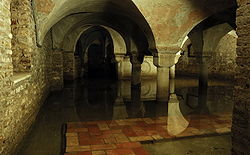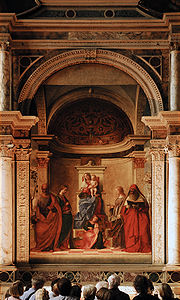
San Zaccaria di Venezia
Encyclopedia

Venice
Venice is a city in northern Italy which is renowned for the beauty of its setting, its architecture and its artworks. It is the capital of the Veneto region...
, northern Italy
Italy
Italy , officially the Italian Republic languages]] under the European Charter for Regional or Minority Languages. In each of these, Italy's official name is as follows:;;;;;;;;), is a unitary parliamentary republic in South-Central Europe. To the north it borders France, Switzerland, Austria and...
, dedicated to St. Zacharias
Zechariah (priest)
In the Bible, Zechariah , is the father of John the Baptist, a priest of the sons of Aaron, a prophet in , and the husband of Elisabeth who is the cousin of Mary the mother of Jesus.In the Qur'an, Zechariah plays a similar role as the father of John the Baptist and ranks him as a prophet alongside...
, the father of John the Baptist
John the Baptist
John the Baptist was an itinerant preacher and a major religious figure mentioned in the Canonical gospels. He is described in the Gospel of Luke as a relative of Jesus, who led a movement of baptism at the Jordan River...
, whose body it supposedly contains. It is a large edifice, located in the quiet Campo San Zaccaria, just off the waterfront to the south east of St. Mark's basilica.

Gothic architecture
Gothic architecture is a style of architecture that flourished during the high and late medieval period. It evolved from Romanesque architecture and was succeeded by Renaissance architecture....
and Renaissance
Renaissance architecture
Renaissance architecture is the architecture of the period between the early 15th and early 17th centuries in different regions of Europe, demonstrating a conscious revival and development of certain elements of ancient Greek and Roman thought and material culture. Stylistically, Renaissance...
styles between 1444 and 1515. Antonio Gambello was the original architect, who started the building in the Gothic style, but the upper part of the facade and the upper parts of the interior were completed by Mauro Codussi
Mauro Codussi
Mauro Codussi was an Italian architect of the early-Renaissance, active mostly in Venice. The name can also be spelt Coducci. He was one of the first to bring the classical syle of the early renaissance to Venice to replace the prevalent Gothic style.Born near Bergamo about 1440, he is first...
in early Renaissance style.
The first church on the site was founded by Doge
Doge of Venice
The Doge of Venice , often mistranslated Duke was the chief magistrate and leader of the Most Serene Republic of Venice for over a thousand years. Doges of Venice were elected for life by the city-state's aristocracy. Commonly the person selected as Doge was the shrewdest elder in the city...
Giustiniano Participazio
Giustiniano Participazio
Giustiniano Participazio was the eleventh or ninth Doge of Venice briefly from 825 to his death. His four years on the ducal throne were very eventful...
in the 9th century and eight doges are buried in the still existing crypt
Crypt
In architecture, a crypt is a stone chamber or vault beneath the floor of a burial vault possibly containing sarcophagi, coffins or relics....
. The original Romanesque
Romanesque architecture
Romanesque architecture is an architectural style of Medieval Europe characterised by semi-circular arches. There is no consensus for the beginning date of the Romanesque architecture, with proposals ranging from the 6th to the 10th century. It developed in the 12th century into the Gothic style,...
church was rebuilt in the 1170s (when the present campanile
Campanile
Campanile is an Italian word meaning "bell tower" . The term applies to bell towers which are either part of a larger building or free-standing, although in American English, the latter meaning has become prevalent.The most famous campanile is probably the Leaning Tower of Pisa...
was built) and was replaced by a Gothic church in the 14th century. The church was attached to a Benedictine
Benedictine
Benedictine refers to the spirituality and consecrated life in accordance with the Rule of St Benedict, written by Benedict of Nursia in the sixth century for the cenobitic communities he founded in central Italy. The most notable of these is Monte Cassino, the first monastery founded by Benedict...
monastery
Monastery
Monastery denotes the building, or complex of buildings, that houses a room reserved for prayer as well as the domestic quarters and workplace of monastics, whether monks or nuns, and whether living in community or alone .Monasteries may vary greatly in size – a small dwelling accommodating only...
, which was visited by the doge annually at Easter
Easter
Easter is the central feast in the Christian liturgical year. According to the Canonical gospels, Jesus rose from the dead on the third day after his crucifixion. His resurrection is celebrated on Easter Day or Easter Sunday...
in a ceremony which included presentation of the cornu
Cornu
Cornu is a Latin word for horn.Cornu may also refer to:*Cornu , an ancient musical instrumentPeople:*Dominique Cornu, a Belgian road and track cyclist, born 1985....
(ducal cap). This tradition was begun after the monks donated land for the extension of the Piazza San Marco
Piazza San Marco
Piazza San Marco , is the principal public square of Venice, Italy, where it is generally known just as "the Piazza". All other urban spaces in the city are called "campi"...
in the 12th century.
The interior of the church has an apse
Apse
In architecture, the apse is a semicircular recess covered with a hemispherical vault or semi-dome...
surrounded by an ambulatory
Ambulatory
The ambulatory is the covered passage around a cloister. The term is sometimes applied to the procession way around the east end of a cathedral or large church and behind the high altar....
lit by tall Gothic windows, a typical feature of Northern European church architecture which is unique in Venice. The church houses one of the most famous work by Giovanni Bellini
Giovanni Bellini
Giovanni Bellini was an Italian Renaissance painter, probably the best known of the Bellini family of Venetian painters. His father was Jacopo Bellini, his brother was Gentile Bellini, and his brother-in-law was Andrea Mantegna. He is considered to have revolutionized Venetian painting, moving it...
, the San Zaccaria Altarpiece
San Zaccaria Altarpiece
The San Zaccaria Altarpiece is a painting by the Italian Renaissance painter Giovanni Bellini, executed in 1505 and located in the church of San Zaccaria, Venice....
. The walls of the aisles are entirely covered with paintings by other artists including Tintoretto
Tintoretto
Tintoretto , real name Jacopo Comin, was a Venetian painter and a notable exponent of the Renaissance school. For his phenomenal energy in painting he was termed Il Furioso...
, Angelo Trevisani
Angelo Trevisani
Angelo Trevisani was an Italian painter of the late-Baroque, active mainly in Venice.He was born in Venice , the brother of Francesco Trevisani who was born in Capodistria, and who painted mainly in Rome under the patronage of cardinal Ottoboni. Angelo was a pupil of Andrea Celesti...
, Giuseppe Salviati, Antonio Balestra
Antonio Balestra
Antonio Balestra was an Italian painter of the Rococo period.Born in Verona, he first apprenticed there with Giovanni Zeffio. By 1690 he moved to Venice, where he worked for three years under Antonio Bellucci, then moved to Bologna and then to paint in Carlo Maratta's workshop in Rome. In 1694, he...
, Giovanni Domenico Tiepolo
Giovanni Domenico Tiepolo
Giovanni Domenico Tiepolo was a Venetian painter and printmaker in etching. He was the son of artist Giovanni Battista Tiepolo and elder brother of Lorenzo Baldissera Tiepolo.-Life history:...
, Palma the Elder and Van Dyck.
The artist Alessandro Vittoria
Alessandro Vittoria
Alessandro Vittoria was an Italian Mannerist sculptor of the Venetian school, "one of the main representatives of the Venetian classical style" and rivalling Giambologna as the foremost sculptors of the late 16th century in Italy....
is buried in the church, his tomb marked by a self-portrait bust
Bust (sculpture)
A bust is a sculpted or cast representation of the upper part of the human figure, depicting a person's head and neck, as well as a variable portion of the chest and shoulders. The piece is normally supported by a plinth. These forms recreate the likeness of an individual...
.

